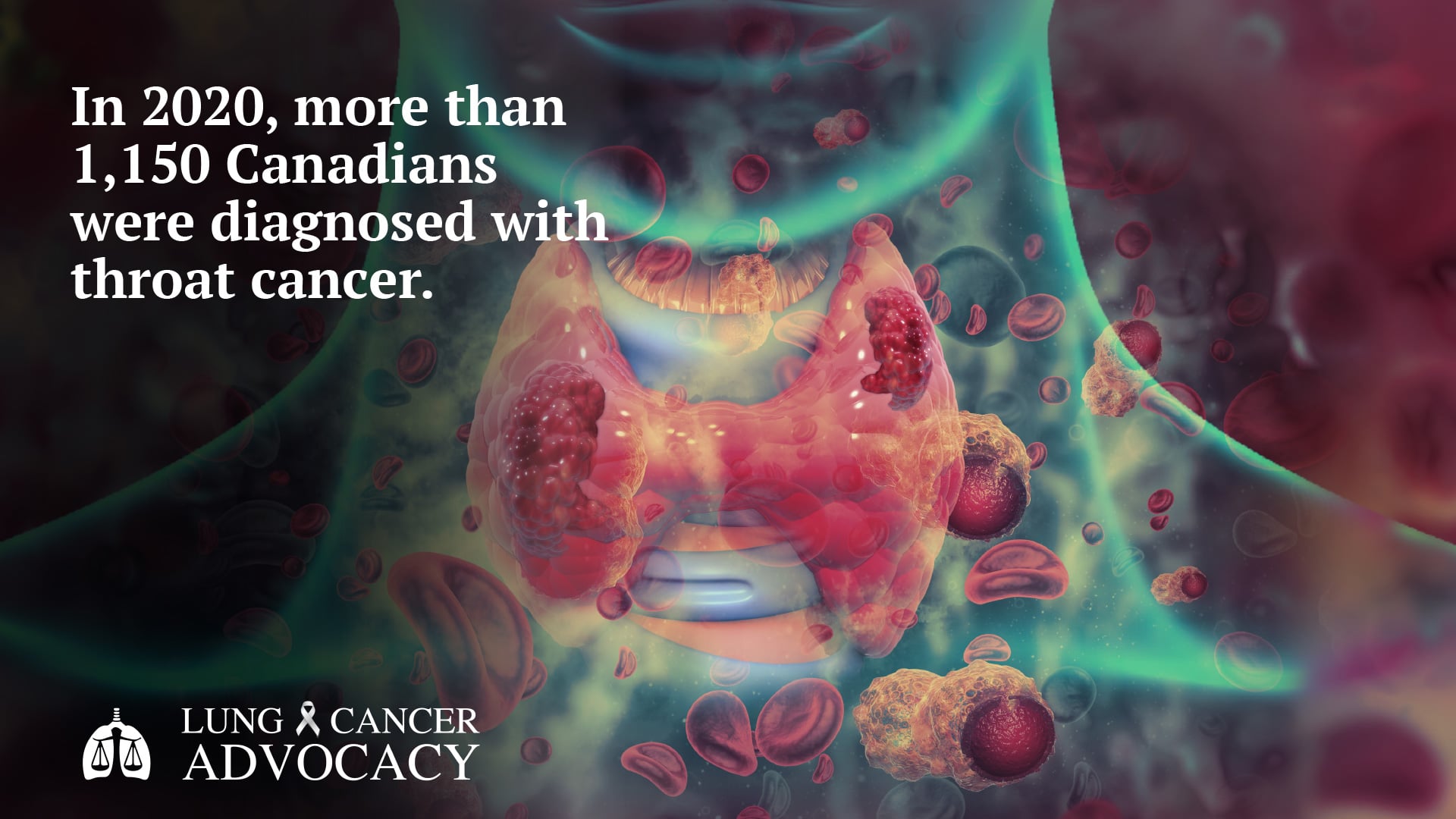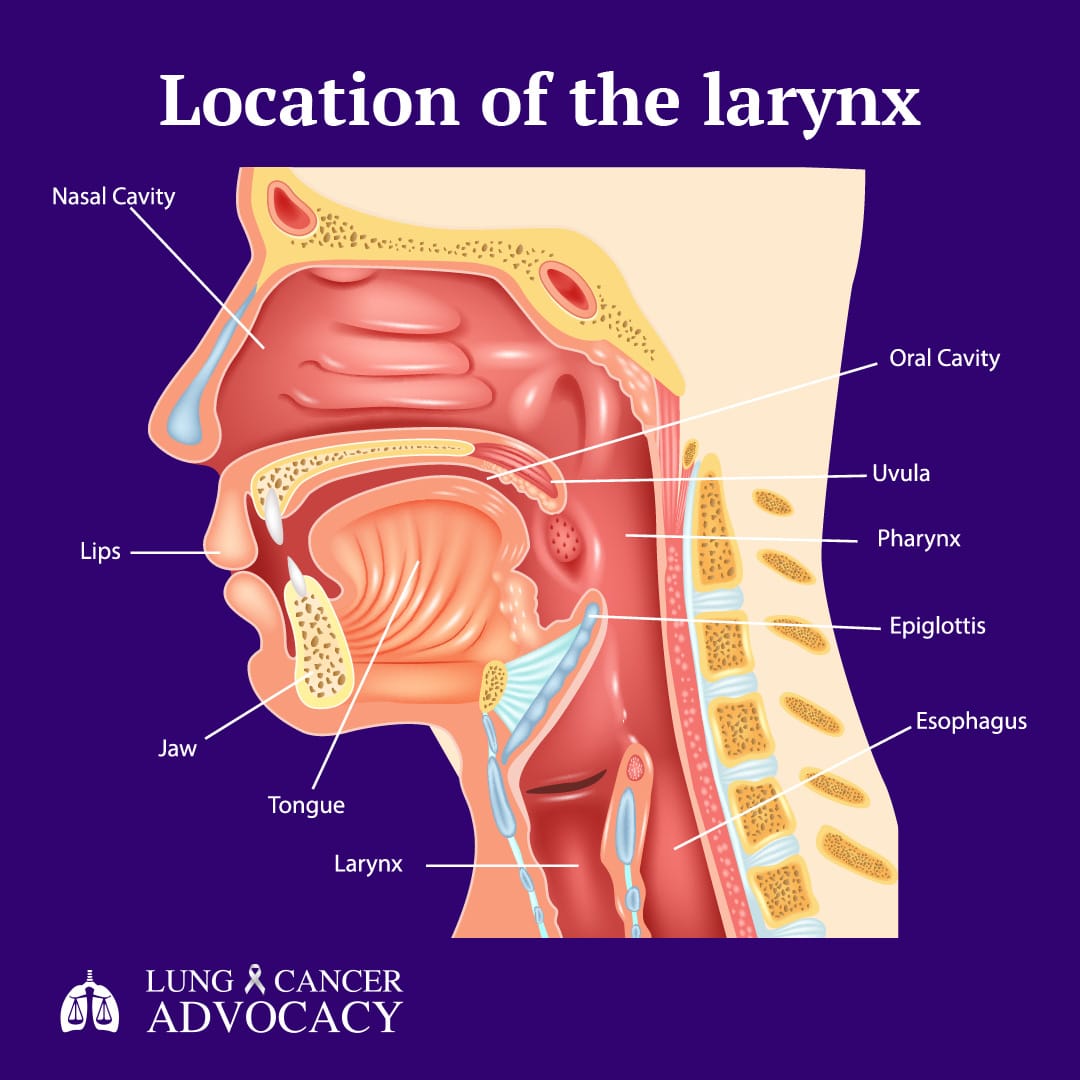Throat Cancer
Throat cancer is classified as a type of head and neck cancer. Head and neck cancers affect more than 4,000 Canadians per year. Throat cancer is an umbrella term for cancers affecting the vocal cords, voice box, tonsils, oropharynx, and other parts of the throat.
Many people who have throat cancer do not realize it right away. The early symptoms can easily be mistaken for other, less serious illnesses. Unfortunately, a delay in diagnosis and treatment can affect the prognosis and response to treatment.

In Canada in 2020, estimates showed a significant number of people affected by throat cancers:
- 1,150 people diagnosed with laryngeal cancer
- 400 people dying of laryngeal cancer
- 980 men diagnosed
- 330 deaths among male patients
- 180 women diagnosed
- 75 deaths among female patients
Facts about Throat Cancer and Smoking
One of the leading contributors to throat cancers is smoking tobacco products. People who smoke one pack of cigarettes per day are six times more likely to develop cancer of the head or neck.
In addition, smokeless tobacco products also increase the risk of developing certain types of throat cancers. That includes chewing tobacco, snuff, and similar products. If you use tobacco products daily and also consume alcohol daily, your risk of throat cancer also increases 20-fold.
If you have lung disease, lung cancer or throat cancer and are a current or former smoker, you may be entitled to compensation.
Click the button below for a FREE case evaluation!
Types of Throat Cancer
Throat cancer is often grouped into two categories – pharyngeal and laryngeal. They are further classified individually depending on the part of the throat that is affected.

Pharyngeal Cancers
Pharyngeal cancers affect the pharynx – the part of the throat between the nose and esophagus. Cancers in this part of the throat are classified as:
- Nasopharyngeal (Upper Throat): The upper part of the throat is called the nasopharnyx. This is the part of the pharynx located behind the nose. The nasopharynx is what connects the nostrils and ears to the throat.
- Oropharyngeal (Mid Throat): The middle part of the throat is called the pharynx. The pharynx is a tube around five inches long that runs from the back of the nose down the neck and becomes part of the esophagus. Cancer in this region of the throat may affect the back of the mouth, tonsils, or the base of the tongue.
- Hypopharyngeal (Lower Throat): The bottom part of the throat and pharynx is called the hypopharynx. This is the part of the throat that allows air and food to pass to the esophagus of windpipe.
Laryngeal Cancer
Laryngeal cancer refers to cancer of the larynx. The larynx is also called the voice box. This is the part of the body that makes sound for verbally speaking. Located below the pharynx, the larynx holds the vocal cords, which vibrate when air is directed against them. The sound and vibration echoes through the pharynx and into the mouth and nose, and that is what makes a person’s voice.
Symptoms of Throat Cancer
The symptoms of throat cancer are similar to that of other head and neck cancers. Some symptoms are also common in people with conditions like asthma, or who have a cold or flu. If you do not have a preexisting condition and are not sick, you should speak with your healthcare provider if you develop symptoms, such as:
- Difficulty swallowing
- Difficulty breathing
- Persistent cough
- Hoarseness
- Swelling of the jaw, throat, neck, or eyes
- Lump in the throat, neck, or mouth
- Pain in the jaw or ear
- White patches in the mouth and/or throat
- Unexplained weight loss
- Headaches
- Bleeding from the nose or mouth
Some symptoms are more common with certain types of cancer, or are specific to certain areas of the body. For example, hoarseness or voice changes may indicate laryngeal cancer, but may not be present with pharyngeal cancers. Often, throat cancer symptoms do not develop until later stages of disease. Many people are only diagnosed with throat cancer after being treated for something completely unrelated. Doctors and dentists often find the signs of throat cancer during routine or unrelated treatment.
Diagnosis and Treatment
Diagnosing throat cancer begins with an examination and review of your medical records. Next, your doctor will likely run some tests:
- Biopsy: Your doctor may order a biopsy to test certain tissues for cancerous cells. A biopsy can be done with a needle, or via a small incision.
- Imaging Tests: Imaging tests can identify the presence of cancerous cells or masses. Doctors may order a CT scan, magnetic resonance imaging (MRI), barium swallow, or positron emission tomography (PET).
- Scoping: Doctors can use a scope to examine the throat. The scope runs through the nose or mouth, down into the throat. These procedures are called laryngoscopy, pharyngoscopy, or a panendoscopy.
Depending on the results of these tests, your doctor will then discuss the best treatment plan. Treatment will depend on the type of cancer, where it is located, and whether or not it has spread. Most often, treatment consists of a combination of:
- Chemotherapy: Chemotherapy is a medication treatment that kills malignant cancer cells and slows down their growth. Chemo and radiation are often done together to target the most cells.
- Radiation: Radiation therapy is a type of treatment that uses high-energy rays to destroy cancerous cells. It targets cancerous cells, or cells left behind after surgery.
- Targeted Therapy: Targeted therapy is a drug treatment that stops growth and spread of cancer cells by interrupting specific molecules that cause tumors to grow.
- Surgery: Surgery for throat cancer is generally to remove cancerous cells and nearby affected tissue. The procedure you have will depend on where the cancer is located. For example:
- Laryngectomy: Removes a portion, or all of, the voice box.
- Pharyngectomy: Removes part of the pharynx.
- Cordectomy: Removes part, or all of, the vocal cords.
- Neck Dissection: Removes damaged tissue including lymph nodes.
There are other types of treatment currently in clinical trials. You can discuss joining a clinical trial with your doctor.
Metastatic Throat Cancer
Throat cancer can spread to other parts of the body. It can spread locally into the mouth, lips, or nearby lymph nodes. It can also spread to other parts of the body. Metastatic throat cancer can develop in the lungs, bones, and lymph nodes in other parts of the body.
Treatment options may be very different from the above if your cancer has spread. Talk to your doctor about what treatment options are right for you depending on your overall diagnosis.
Learn More about Lung Injuries
There is no question that being diagnosed with throat cancer is a life-changing experience. If your cancer was caused by tobacco products or exposure to chemicals or toxins, your diagnosis can be even more emotional. Of course, you want answers.
At Lung Cancer Advocacy, our goal is to help families find answers to their concerns. Whether you were exposed to crystalline silica dust, asbestos, or chemicals in tobacco products, we want you to be informed about your legal rights.
Learn more about lung injuries and your rights by contacting us for a free consultation. Call us at (866) 541-5812, or sign up online to learn more.
Sources:
- https://www.mountsinai.on.ca/care/cancer/cancers-we-treat/joseph-and-mildred-sonshine-family-centre-for-head-and-neck-disease/cancers-of-the-head-and-neck
- https://cancer.ca/en/cancer-information/cancer-types/laryngeal/
- https://www.healthlinkbc.ca/health-topics/hw183854
- https://www.cancercenter.com/cancer-types/throat-cancer/symptoms